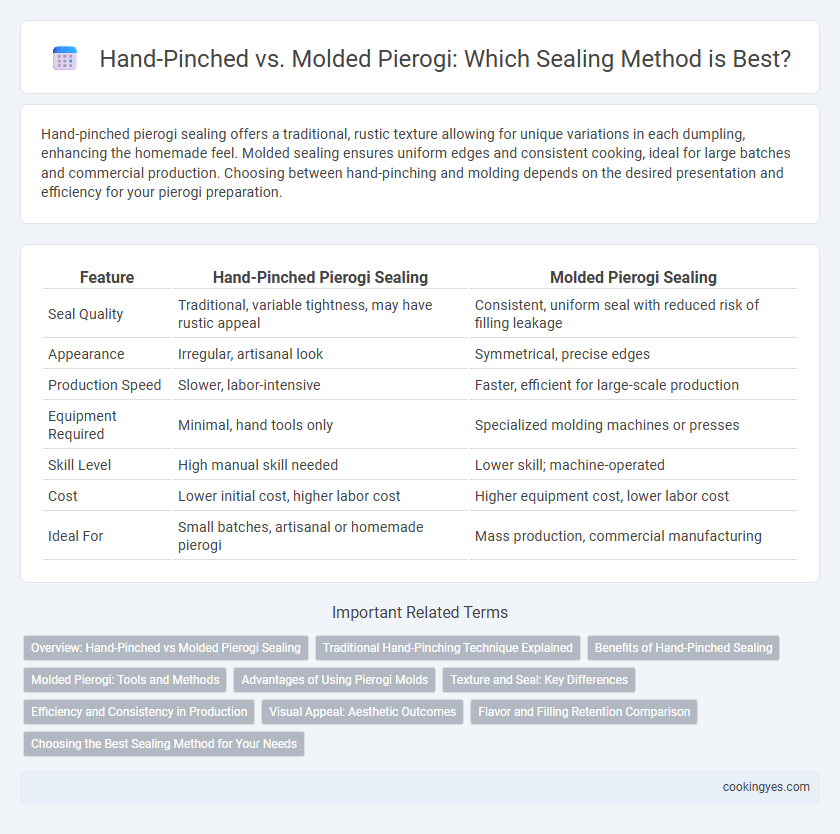Hand-pinched pierogi sealing offers a traditional, rustic texture allowing for unique variations in each dumpling, enhancing the homemade feel. Molded sealing ensures uniform edges and consistent cooking, ideal for large batches and commercial production. Choosing between hand-pinching and molding depends on the desired presentation and efficiency for your pierogi preparation.
Table of Comparison
| Feature | Hand-Pinched Pierogi Sealing | Molded Pierogi Sealing |
|---|---|---|
| Seal Quality | Traditional, variable tightness, may have rustic appeal | Consistent, uniform seal with reduced risk of filling leakage |
| Appearance | Irregular, artisanal look | Symmetrical, precise edges |
| Production Speed | Slower, labor-intensive | Faster, efficient for large-scale production |
| Equipment Required | Minimal, hand tools only | Specialized molding machines or presses |
| Skill Level | High manual skill needed | Lower skill; machine-operated |
| Cost | Lower initial cost, higher labor cost | Higher equipment cost, lower labor cost |
| Ideal For | Small batches, artisanal or homemade pierogi | Mass production, commercial manufacturing |
Overview: Hand-Pinched vs Molded Pierogi Sealing
Hand-pinched pierogi sealing creates a rustic, artisanal texture with slightly uneven edges, enhancing the traditional experience. Molded pierogi sealing offers uniformity and efficiency, producing consistently shaped dumplings ideal for mass production. Both methods effectively seal the filling, but hand-pinching emphasizes craftsmanship while molding prioritizes speed and consistency.
Traditional Hand-Pinching Technique Explained
The traditional hand-pinching technique for sealing pierogi involves carefully folding the dough over the filling and pressing the edges together to create a secure, crimped seal that prevents leakage during cooking. This method allows for precise control over the thickness and shape of each dumpling, preserving the authentic texture and appearance characteristic of homemade pierogi. Hand-pinching also contributes to the signature rustic look and ensures that the filling remains evenly distributed throughout the cooking process.
Benefits of Hand-Pinched Sealing
Hand-pinched sealing of pierogi offers superior control over dough thickness and filling distribution, ensuring a uniform texture and preventing leaks during cooking. This traditional method enhances the pierogi's rustic appearance and retains more moisture, resulting in a tender and flavorful bite. Chefs often prefer hand-pinching because it allows for precise customization, adapting seals to different fillings and dough consistencies.
Molded Pierogi: Tools and Methods
Molded pierogi sealing involves specialized tools such as pierogi molds or presses that ensure uniform edges and consistent shapes, improving cooking and presentation quality. These tools typically feature a hinged design with patterned edges that crimp and seal the dough efficiently while preventing filling leakage. Automated machines for molded pierogi production enable high-volume output with precision, making this method popular in commercial settings.
Advantages of Using Pierogi Molds
Pierogi molds streamline the sealing process by ensuring uniform edges and consistent portions, which enhances presentation and cooking quality. They reduce preparation time substantially compared to traditional hand-pinching, increasing efficiency in both home and commercial kitchens. Using molds also minimizes dough wastage, providing a more sustainable and cost-effective approach to pierogi preparation.
Texture and Seal: Key Differences
Hand-pinched pierogi sealing creates a rustic texture with uneven ridges that enhance dough bite and provide a homemade feel. Molded pierogi sealing delivers a uniform, smooth edge with a tighter, more consistent seal that reduces the risk of filling leakage during cooking. Texture differences affect mouthfeel, while seal integrity influences durability in boiling or frying processes.
Efficiency and Consistency in Production
Hand-pinched pierogi sealing offers artisanal quality with a unique texture but results in slower production and variable consistency. Molded sealing significantly increases efficiency by standardizing shape and ensuring uniform sealing, reducing production time and minimizing waste. Automated molds enable high-volume pierogi manufacturing with consistent dough thickness and filling distribution, optimizing both quality and output.
Visual Appeal: Aesthetic Outcomes
Hand-pinched pierogi showcase a rustic, artisanal look with uneven, textured edges that emphasize homemade authenticity, appealing to consumers seeking traditional craftsmanship. Molded pierogi, by contrast, deliver consistently uniform shapes and smooth, clean seals that enhance visual symmetry, ideal for commercial presentation and plating precision. The choice between hand-pinched and molded sealing directly influences the pierogi's aesthetic outcome, affecting both consumer perception and market positioning.
Flavor and Filling Retention Comparison
Hand-pinched pierogi create a tighter seal that better retains juices and fillings, preserving the rich, savory flavors inside. Molded pierogi offer a uniform shape but may have small gaps that allow filling to leak during cooking, resulting in less concentrated taste. The artisanal hand-pinching technique enhances texture and flavor retention, making it preferable for maintaining the integrity of traditional pierogi fillings.
Choosing the Best Sealing Method for Your Needs
Hand-pinched pierogi sealing offers a traditional, artisanal touch that enhances texture and flavor through slight variations in dough thickness and shape, ideal for homemade or small-batch cooking. Molded sealing provides consistent edges and uniform shapes, increasing production speed and ensuring a professional appearance, which suits commercial kitchens or large-scale preparation. Selecting the best method depends on whether prioritizing craftsmanship and uniqueness or efficiency and uniformity for your specific culinary needs.
Hand-Pinched vs Molded for Pierogi Sealing Infographic

 cookingyes.com
cookingyes.com